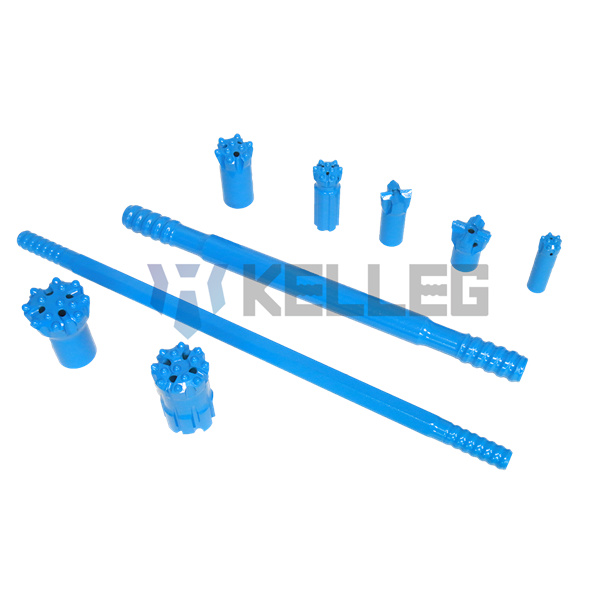2020 官网升级中!现在您访问官网的浏览器设备分辨率宽度低于1280px请使用高分辨率宽度访问。
The rapid development of rock drilling equipment promotes the continuous development of rock drilling tools. As the application of rock drilling tools becomes more and more extensive, the market has higher and higher requirements for the performance of rock drilling tools. Large heavy-duty rock drilling machines such as hydraulic rock drilling rigs have a large request for drilling tools during rock drilling, and this kind of rock drilling tools generally called heavy-duty rock drilling tool, has a large section, a long length, a single piece of heavyweight, high impact resistance, fast rock drilling speed, and high energy utilization. Therefore, the market demand for high-quality heavy drilling tools is also increasing.

The structure of a high-quality drilling tool is the main factor that decides its quality and service life. Although in the production process, every step can affect the structure and properties of the rock drilling tools, affecting its quality and service life, the most basic is the steel used for the rock drilling tools. For example, the steel used in heavy-duty rock drilling tools requires good strength and toughness to ensure its wear resistance and impact resistance, and it also requires good processing performance and certain corrosion resistance. In response to this, we will share with you the performance requirements of steel for heavy-duty rock drilling tools.
Due to different resources, manufacturing processes, and technologies in different countries, the steel used for heavy-duty drills is not the same. It can include carbon rock drill steel and alloy rock drill steel. And carbon rock drill steel is getting harder to keep up with demand in people’s practice. So, in the process of looking for new steel grades, alloy rock drill steel was born, and this is what we are going to share.
As we all know, the rock drilling tools consists of four parts: the drill bit, the drill rod, the shank adapter, and the coupling sleeve. According to the different service conditions of each part of the rock drilling tools, the performance requirements for alloy steel are also different. Since the coupling sleeve is relatively simple, we will not introduce its performance requirements too much here. The performance requirements of the drill bit, drill rod, and shank adapter are as follows.
1. Performance requirements for the drill bit
The composition of the rock drill bit is to inlay or weld the rock drill carbide on the alloy steel carrier. In the process of working, the drill bit is in direct contact with rock, which needs to bear the cyclic load of tension, extrusion, torsion, bending, and other loads, as well as the corrosion of rock, mineral water, and other media, so it is the most easily damaged part of rock drilling tools. Because of this, its performance requirements are mainly high enough surface hardness, good strength and toughness matching, good processing performance, and corrosion resistance.
2. Performance requirements for drill rods
In the process of rock drilling, the heavy-duty drill rod mainly relies on the connection between the external thread of the threaded connection drill rod and the internal thread of the coupling sleeve or the drill bit, drilling holes through the rotary impact of the rock drill. During rock drilling, the drill rod mainly bears the combined action of the high-frequency percussion of the rock drill piston and the propeller thrust. At the same time, at the moment of rock drilling, the rock also produces a reaction force to the drill rod through the drill bit. Therefore, the drill rod bears axial high-frequency compression pressure and high-frequency tensile stress in the rock drilling process, as well as torsional and bending stress. This requires the performance of the drill rod to meet higher fatigue strength, impact toughness, corrosion resistance, lower notch sensitivity, and crack growth rate.
3. Performance requirements for shank adapter
The shank adapter directly bears the high-frequency impact of the rock drill, so it works under high speed, high frequency, and strong impact conditions. Therefore, it is also a key part of the hydraulic rock drill. According to the working conditions of the shank adapter, its performance requirements are mainly that its core should not only have good toughness but also have enough strength to make it have high impact contact fatigue resistance. At the same time, because the shape of the shank adapter has particularity and complexity, the material selection of the shank adapter must have a certain hardenability to balance the bending fatigue strength.
The above is about the performance requirements of steel for heavy-duty rock drilling tools, whether, for drill bits, drill rods, or shank adapters, these performance requirements are in connection with their service conditions. Therefore, when people face more geological conditions, there will be more demand for the performance of steel for heavy-duty rock drilling tools. Based on this, no matter manufacturers or research centers, it is needed to continuously study steel for heavy-duty rock drilling tools, through the comprehensive control of smelting, rolling, forging, machining, and heat treatment to improve the quality level of steel for heavy-duty rock drilling tools.